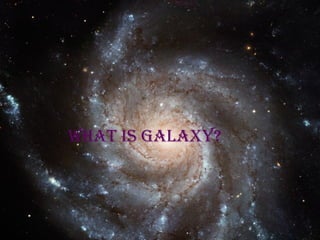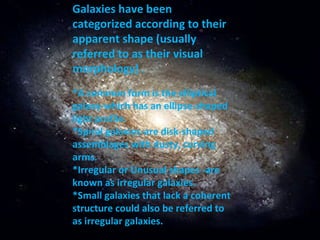Opaw
- 2. A galaxy is a massive, gravitationally bound system that consists of stars and stellar remnants, an interstellar medium of gas dust, and an important but poorly understood component tentatively dubbed dark matter. .
- 3. The name is from the Greek root galaxias , literally meaning "milky", a reference to the Milky Way galaxy. Typical galaxies range from dwarfswith as few as ten million stars up to giants with a hundred trillion stars, all orbiting the galaxy's center of mass
- 4. Galaxies may contain many multiple star systems, star clusters and various interstellar clouds. The Sun is one of the stars in the Milky Way galaxy; the Solar System includes the Earth and all the other objects that orbit the Sun.
- 5. Galaxies have been categorized according to their apparent shape (usually referred to as their visual morphology) . *A common form is the elliptical galaxy-which has an ellipse-shaped light profile. *Spiral galaxies-are disk-shaped assemblages with dusty, curving arms. *Irregular or Unusual shapes -are known as irregular galaxies. *Small galaxies that lack a coherent structure could also be referred to as irregular galaxies.
- 6. There are probably more than 170 billion galaxies in the observable universe. Intergalactic space (the space between galaxies) is filled with a tenuous gas of an average density less than one atom per cubic meter. The majority of galaxies are organized into a hierarchy of associations called clusters, which, in turn, can form larger groups called superclusters .These larger structures are generally arranged into sheets and filaments which surround immense voids in the universe.





